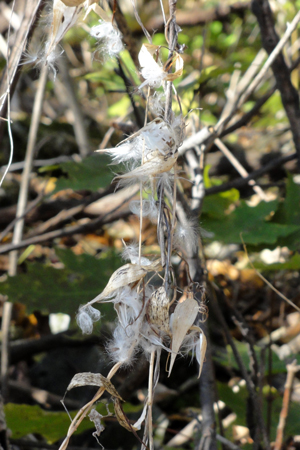by Liz Magnanti

Vincetoxicum rossicum, pale swallowwort (dogstrangling vine) at the Skaneateles Conservation Area, Onondaga County, New York. Photo by R. A. Nonenmacher
Fall cleanup is an inevitable part of preparing for the winter months ahead. Raking, cleaning out the gutters, and cleaning up plant debris can be tedious. The good news is, sometimes the messier the garden the better it is for wildlife!
Many plants will offer seeds to birds like goldfinches, juncos, and pine siskins in the winter. Black-eyed Susan and purple coneflower are great examples that can be left all winter for birds to feed from. There is no need to deadhead or remove stalks of these plants now—it can wait until the spring. If you are cleaning out dead plant stalks in your garden, be on the lookout for the chrysalis of butterflies and the cocoons of moths. Swallowtails are one example of a butterfly that will spend all winter in their chrysalis. Other species like the Mourning Cloak butterfly will spend the winter as an adult and will hibernate in tree crevices or brush piles. On an unseasonably warm winter day you may even see some of these butterflies flying over your snowcovered garden.
Weeding out perennial invasives that are popping up in the garden is a good idea in the fall so their root system doesn’t expand more than it already has. Black swallowwort is a plant that is creeping into gardens at an alarming rate. It can easily take over gardens in a small amount of time due to its excellent seed dispersal and subterranean rhizome system. It looks like a vine, can wrap itself around other plants, and has slender seed pods similar to other milkweed species. Digging out this and other unwanted plants will make spring gardening easier. Also known as “dog strangling vine,’ this beast is harmful to our Monarch population.
Now is a good time to collect seeds from plants you want to propagate. Read up on the plant species because some, like milkweeds and cardinal flower, sprout better with cold stratification—this means they need to be left out in the cold in order to sprout. This can also be accomplished by keeping the seeds in the refrigerator for two to three months.
Sticks and branches cleaned up from the yard can be saved and arranged to make a brush pile. Brush piles are places for small mammals, birds and amphibians to take refuge. Hawks commonly come into yards in the winter to search for an easy meal and having a brush pile will give their potential prey a place to escape. You can add leaves and grasses to your brush pile to provide even more protection and places to hide.
Putting up a roosting house, or roosting pockets, is another way to give birds protection in the winter. A roosting house looks like a bird house but it has perches along the inside of it. These perches allow for several birds to occupy the space at once. Multiple species, even birds that don’t nest in houses, will use these roosting houses to stay out of the snow, rain, and wind. They are usually made of woven plant fibers or coconut shells. Birdhouses can also be left out in the winter. Birds or even mice will use them for protection as the weather turns.
Once the temperature drops you may see more activity at your bird feeders. This time of year it is important to make sure your feeders are clean and the seed you are feeding them is fresh. Birds are warm blooded and need to consume many calories in order to keep their body temperature up. Peanuts, sunflower, nyjer, and safflower seeds are high in fat and are a great source of food for birds in the winter. Peanuts tend to attract chickadees, titmice, nuthatches, woodpeckers and blue jays. Sunflower and safflower seeds will attract cardinals, finches, sparrows, and more. Nyjer seed is a favorite of finches, especially goldfinches. Goldfinches are in the area all winter long, but they molt their feathers and will be a drab olive color. In the winter it is common to see pine siskins and sometimes redpolls at nyjer feeders. These birds migrate here from Northern Canada for the winter. Suet cakes, which are blocks of fat, are especially attractive to woodpeckers.
Water can be hard to come by for wildlife in winter. Many species of birds and small mammals depend on a shallow, unfrozen sources of water to drink and bathe in. You can provide this in your yard by using a heated birdbath or by putting a heater in an existing birdbath. These heaters operate on a thermostat and don’t make the water warm, but they keep it unfrozen.
Providing wildlife with food, water, and shelter from the elements and predators is important all year if you want to have a wildlife-friendly yard. You may find, however, when you provide these elements in the winter the amount of animals you see goes up significantly. When we have long periods of cold and snow cover, it can be hard for wildlife to find a meal, a drink, or safety. Now is the perfect time to prep your yard for the cold months ahead. The animals will appreciate the additional help, and you will appreciate their wonderful presence in your yard all winter long.
Liz Magnanti is the manager of the Bird House in Pittsford.
Views: 0






